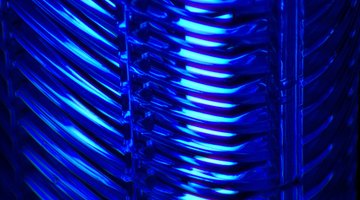Pros & Cons of Germicidal Ultra Violet Light for Heating & Cooling Systems
Germicidal ultraviolet (UV) lights are used in scientific procedures and air-conditioning systems to kill microorganisms both in the air and on nearby surfaces. The lights use unique bulbs that produce c-type ultraviolet wavelengths, which are dangerous to living organisms and fatal to those small enough to float through the air with dust particulates. There are both benefits and problems involved in using UV lights.
Effectiveness

UV lights are useful because of their effectiveness. As long as the air is not passing dust particles through the filters at speeds too high for the light to be effective, the UV lamp can kill over 99 percent of any microorganisms in the air, including bacteria, viruses and mold spores. Few other filters can match their effectiveness.
Energy Savings
Some ultraviolet filters are placed directly above air-conditioning systems to kill any microorganisms near the heat or cooling coils of the system. This keeps the system from develop mold problems, and with an additional filter, also helps prevent the collection of dust. In turn, the air-conditioning system can run more efficiently, saving energy.
Flexible Placement
There are several different types of UV filter lights, and they can be placed not only over air-conditioning systems, but inside vents and even in rooms as stand-alone units. The lamps must be shielded from people, but they do provide an easy way to disinfect rooms that are not part of the air-conditioning system and cannot easily vent out contaminants.
Limitations
While UV lights are effect at killing living materials, they cannot touch the particles themselves. This means that pollen and damage can still float free as dust, creating cleaning problems. The UV light must be used with additional filters to be effective at both disinfecting and dust removal.
Dust
Dust creates another problem for the UV lights. As it passes in front of the bulb, it collects on the bulb's surface. Over time, this lowers the effectiveness of the bulb, which must be wiped clean frequently in dusty environments. Because of the danger to people, the UV system must be fully shut down before anyone can conduct any maintenance.
Replacement
UV bulbs are short-lived. While they may continue to operate after a year, their UV light content has drastically diminished by then, requiring owners to replace the bulbs annually. This can be a significant added expense that may overshadow savings related to more efficient energy use.
References
Writer Bio
Tyler Lacoma has worked as a writer and editor for several years after graduating from George Fox University with a degree in business management and writing/literature. He works on business and technology topics for clients such as Obsessable, EBSCO, Drop.io, The TAC Group, Anaxos, Dynamic Page Solutions and others, specializing in ecology, marketing and modern trends.
Photo Credits
- uv light. image by Harvey Hudson from Fotolia.com
More Articles



